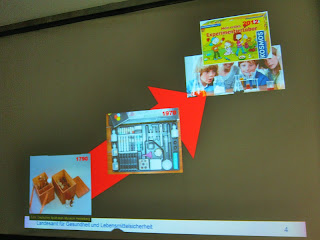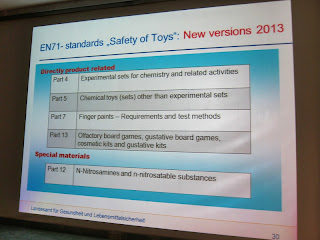The Seminar entitled "Testing for Toy Safety: EU's Latest Requirements" was joinly organized by the Hong Kong Council for Testing and Certification (HKCTC), the Hong Kong Accreditation Service (HKAS) and Hong Kong Toys Council (HKTC) on 22 October 2012.
Ms. Maureen Logghe (Policy Officer - SNE, DG Entreprise and Industry, European Commission) gave an opening remarks. She hoped that we could work together to enhance the safety aspects in Toys.
The first speaker was Ms. Maureen Logghe (Policy Officer - SNE, DG Entreprise and Industry, European Commission) and her topic was "Toy Safety Directive: classification issues and new guidelines, technical documentation, Frequently Asked Questions". Ms. Logghe speech was separated into four parts included time schedule, classification, documents and future changes.
The time schedule of Directive 2009/48/EC was shown below. The directive for chemical requirement would be effective on 20 July 2013. (OJEU stands for the Official Journal of the European Union)
"Toys" is defined as "products designed or intended, whether or not exclusively, for use in play by children under 14 years of age". The following reference sites were described.
Toys - Guidance documents from the Expert Group on Toy Safety: http://ec.europa.eu/enterprise/sectors/toys/documents/guidance/
Questions & Answers about Toy Safety: http://ec.europa.eu/enterprise/sectors/toys/faq/index_en.htm
Chinese version of Directive 2009/48/EC: http://ec.europa.eu/enterprise/sectors/toys/files/technical-documentation-guidance/20110405_technical_documentation_guidance_document_rev_1-0_chinese.pdf
The possible amendments and implementing measures were shown as follow diagram.
Preparing legislative proposals, the European Commission would rely on the opinion by the scientific expertise whose drafting legislation assessing and dealing with risk.
Scientific committee: http://ec.europa.eu/health/scientific_committees/index_en.htm
Some information about migration limits were shown below.
Cadmium - http://eur-lex.europa.eu/LexUriServ/LexUriServ.do?uri=OJ:L:2012:064:0007:0008:EN:PDF
Lead - http://ec.europa.eu/enterprise/sectors/toys/public-consultation-lead/index_en.htm
Barium - http://ec.europa.eu/health/scientific_committees/environmental_risks/docs/scher_o_161.pdf
CMR (Carcinogenic, Mutagenic, Reprotoxic) substances included Tris(2-chloroethyl)phosphate (TCEP), Tris (1-chloro-2-propyl) phosphate (TCPP), Tris(1,3-dichloro-2-propyl)phosphate (TDCP)
Opinion SCHER: http://ec.europa.eu/health/scientific_committees/environmental_risks/docs/scher_o_158.pdf
Competent Authorities for REACH and CLP (CARACAL)
REACH - Registration, Evaluation, Authorisation and Restriction of Chemicals
CLP/GHS - Classification, labelling and packaging of substances and mixtures
http://ec.europa.eu/enterprise/sectors/chemicals/reach/caracal/index_en.htm
Future information - http://ec.europa.eu/enterprise/sectors/toys/index_en.htm
The second speaker was Dr. Vincent Tam (Technical Chair, HKTC / Director of Systems and Compliance, Jetta Company Ltd.) and his presentation entitled "The Chemical and Documentation Challenges of Toy Industry". Dr. Vincent would briefed the challenges from chemical and documentation, as well as, HKTC-Chemical Management Database (CMD).
Dr. Tam introduced the history that the formal efforts to assure toy safety by TIA began in early 1930s. In late 1969, President Nixon signed into law the Toy Safety Act in USA. The following acts about chemical were showed.
Some chemical challenges were mentions.
- TSD 2009/48/EC - The revised Directive brings in more references on chemicals by limiting the amounts of certain chemicals (19 heavy metals) and CMR substances are no longer allowed in accessible parts of toys. It is required comprehensive chemical data in Bill of Substance (BOS) and Safety Data Sheet (SDS) to conduct chemical safety assessment.
- REACH EC1907/2006 currently 84 substances are concerned.
- Washington's Children's Safety Products Act
- Maine's Kid-Safe Products Act Amendment
- California's Green Chemistry Initiative - Safer Consumer Products Regulations (draft)
Chemicals of Concern (COC) lists around the globe were showed below.
EU TSD documentation requirements were briefed (it needed to keep for 10/5 years)
At the end, Dr. Tam introduced the Chemical Management Database (CMD) to industry. It aims one industry on system to achieve CASE - Cost minimization, Alignment in early stage, Standardization and EDI exchange.
Mrs. Shima Dobel (Head of Section, Chemical Division, Danish Environmental Protection Agency) was the third speaker and his presentation named "Chemical requirements: relationship with EU legislation (e.g. REACH) and chemical safety assessment".
Mrs. Dobel introduced different Toy Safety Directives. She said Toys should be designed and manufactured in such a way that there were no risks of adverse effects on human health due to exposure tot he chemical substances or mixtures of which the toys were composed or which they contained.
New requirements included:
- Migration limits for 19 elements (included aluminium, antimony, arsenic, barium, boron, cadmium, chromium(III) and (VI), cobalt, copper, lead manganese, mercury, nickel, selenium, strontium, tin, organic tin and zinc) in three different toy materials (I-Dry, power-like or pliable; II-Liquid and stricky; and III-Scraped-off.)
- Ban of CMR substance above the classification limit (see diagram below)
- Ban of 55 allergenic fragrances
- Duty to inform if content of 11 allergenic fragrences
- Migration limit for nitrosamines (0.05mg/kg) and nitrosatable substances (1mg/kg) in certain toys
- Chemical safety assessment
Guideline on the interpretation of the concept "which can be placed in the mouth" as laid down in the entry 52 of Annex XVII to REACH Regulation 1907/2006
http://ec.europa.eu/enterprise/sectors/toys/files/gd008_en.pdf
- Mechanical, physical, flammability and electrical hazards
- Hygiene and radioactivity
- Chemical hazards
Q&A Session
Ms. Krista Bouma (Public Health Officer, The Netherlands Food and Consumer Product Safety Authority) was the fourth speaker and his topic entitled "Chemical requirement: draft standards EN71-3 migration of elements".
In the beginning, Ms. Bouma introduced Toy Safety Directive 88/378/EEC and 2009/48/EC. RIVM report entitled "A general methodology for assessment of chemical safety of toys with a focus on elements" was briefed - http://www.rivm.nl/bibliotheek/rapporten/320003001.pdf; as well as, an explanatory guidance document of TSD 2009/48/EC - http://ec.europa.eu/enterprise/sectors/toys/files/tsd-guidance/tsd_rev_1-5_explanatory_guidance_document_en.pdf
Then Ms. Bouma introduced the new EN71-3. The sample preparation and migration which was similar to current standard. Migration solution was analysed directly by ICP-MS or ICP-OES in one run. Comparison to current EN71-3, the new one was analysed more elements and lower limits (especially category II toy type). The following example was used ICP-MS to distinguish Chromium (III) and (VI).
Guideline on the interpretation of the concept "which can be placed in the mouth" as laid down in the entry 52 of Annex XVII to REACH Regulation 1907/2006
http://ec.europa.eu/enterprise/sectors/toys/files/gd008_en.pdf
- Mechanical, physical, flammability and electrical hazards
- Hygiene and radioactivity
- Chemical hazards
Ms. Krista Bouma (Public Health Officer, The Netherlands Food and Consumer Product Safety Authority) was the fourth speaker and his topic entitled "Chemical requirement: draft standards EN71-3 migration of elements".
In the beginning, Ms. Bouma introduced Toy Safety Directive 88/378/EEC and 2009/48/EC. RIVM report entitled "A general methodology for assessment of chemical safety of toys with a focus on elements" was briefed - http://www.rivm.nl/bibliotheek/rapporten/320003001.pdf; as well as, an explanatory guidance document of TSD 2009/48/EC - http://ec.europa.eu/enterprise/sectors/toys/files/tsd-guidance/tsd_rev_1-5_explanatory_guidance_document_en.pdf
Then Ms. Bouma introduced the new EN71-3. The sample preparation and migration which was similar to current standard. Migration solution was analysed directly by ICP-MS or ICP-OES in one run. Comparison to current EN71-3, the new one was analysed more elements and lower limits (especially category II toy type). The following example was used ICP-MS to distinguish Chromium (III) and (VI).
Finally, she briefed the time line and future development of new EN71-3.
The last speaker was Dr. Bertram Reindl (Head of Product Safety Division, Bavarian Health & Food Safety Authority) and his topic entitled "Chemical requirements: draft standards EN71-4 and 5, 7, 12 and 13".
Dr. Reindl said the tools for pharmacist in 1790 developed into two ways. One is now medical devices and the other way is Toys.
Then he explained Chemical Toy as "toy intended for the direct handling of chemical substances and mixtures and which is used in a manner appropriate to a given age-group and under the supervision of an adult". The classification of chemical toys in EN71-4 and EN71-5 were showed below.
EN71-7 is for finger paints included colourants and preservatives.
EN71-12 is for N-Nitrosamines and N-Nitrosaatable substances.
EN71-13 is for olfactory board games, gustative board games, cosmetic kits and gustative kits.
Reference:
HKCTC - http://www.hkctc.gov.hk/en/about.html
HKAS - http://www.itc.gov.hk/en/quality/hkas/about.htm
HKTC - http://www.toyshk.org/

























沒有留言:
發佈留言